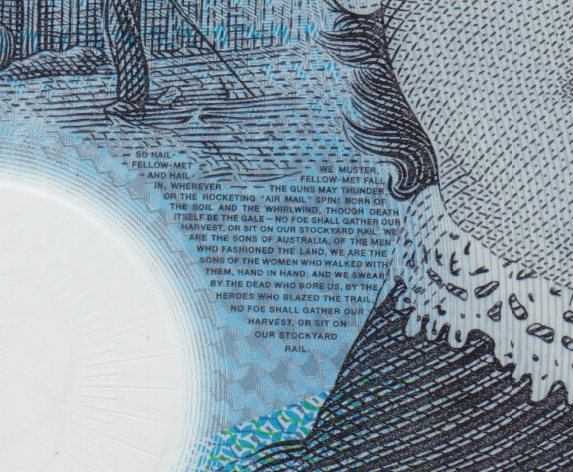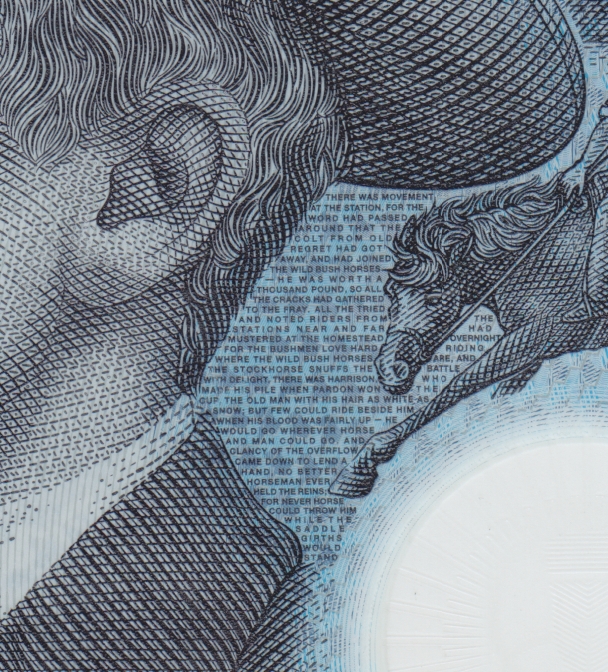It Turns Out That Australia's Much-Vaunted NGB $50 Note Has A Spelling Mistake On It

I got a phone call at 630am on the morning of May 9th 2019 - as someone that was the President of a sporting club I’ve long passed the point of being surprised by a random phone call at an odd hour of the day or night, but this was the first in a while.
On the other end of the line was the producer of a morning breakfast show with one of Perth’s radio stations (6PR), who’d seen something online about a spelling mistake on the Next Generation Banknote, issued into circulation in September 2018.

2018 AA18 First Prefix NGB $50 Banknote
It turns out that someone in Victoria had been examining the micro print on the front of the note, and noticed that the word “responsibility” had been spelt incorrectly no less than three times!
I didn’t believe that such an error could happen when I was first told of it, but sure enough when a photograph of an enlarged section of the note arrived via text message moments later, it was hard to argue otherwise.
I found it hard to conceive that such a minor yet fundamental error could have passed through the multiple stages of checks that we’d expect from the Reserve Bank of Australia, so reserved my judgement until I had the opportunity to look into it further.
My first thought was that the original text that was reproduced in micro print may have contained the spelling errors, and although incorrect, it was reproduced faithfully for reasons of historical accuracy.
A quick check of the Hansard of the WA Parliament put paid to that theory pretty quickly - Dame Edith Cowan’s maiden speech was recorded and reproduced there in full, and no such spelling errors can be found!
The idea that Hansard itself was incorrect simply isn’t possible, as it was the written record of a verbal speech, and not a transcript of another written document.
The Reserve Bank of Australia has since advised several media outlets that they were made aware of the error in December 2018 (just three months after the notes entered circulation), which to me is confirmation that the mis-spelling is the result of human error rather than any preference for historical accuracy.
So how can an error like this happen? I think a statement from the RBA’s press release provides the perfect explanation - "We have reviewed our processes to remove the likelihood of such an error occurring in the future”.
Although there was one designer responsible for the micro-engraving, it’d be quite harsh to lay any blame at his feet alone. It’s quite a unique skill set to be able to design a currency note, it perhaps isn’t fair that creative soul was also expected to vet their own work to ensure it was perfect in every way - the design and vetting processes are quite separate and distinct.
Complex projects such as this involve hundreds, if not thousands of people, and the micro-print designs would have passed by many hands and before many pairs of eye balls before they entered circulation. That statement points to the process being the source of the problem, and that it’s not simply the fault of the people involved that the spelling error saw the light of day.
One of the interesting questions to come out of this story is "Just who has the time, tools and inclination to examine the banknotes they have in their wallet so closely that they can discover an error such as this?” I’m a professional numismatist and study banknotes for a living, and I’ve never been compelled to get a magnifying glass out and study the micro print on any of the notes in my wallet!
For the sake of putting everyone’s concerns at ease, we’ve scanned the micro-print sections of the other NGB notes that have been issued so far - there aren’t any other spelling errors on them as far as we can see!
Will These Notes be Valuable in the Future?
We need to keep in mind that no less than 46 million of these notes have been issued into circulation so far, and that many (many!) more notes may have been printed and are yet to be introduced into circulation. 46 million is near enough to the number required for every man, woman and child to have 2 each.
When we also keep in mind that there are no less than 710 million $50 notes in circulation, we can see that in and of themselves, they sure ain’t going to be rare any time soon!
Is It Worth Setting Any of These Notes Aside?
This question is best answered by reminding ourselves that we collect things for many reasons, and not just in the hope that something will be worth squillions in future.
Which Ones Should I Set Aside?
As there are no less than 46 million of these notes in circulation so far, I’d be fairly selective about any $50 note that I set aside.
I’d check any potential nest egg to make sure that it’s in absolutely spanking mint condition (that is, without any flicks, folds or even tiny dents in it!), and then I’d really only be inclined to keep either or both of a first prefix or a last prefix.
The first prefix for the NGB $50 note is AA18, while the last prefix for the NGB $50 note is IB 18.
One of those in 20 years time, coupled with a newspaper report on the whole escapade will be a great thing to look back on.
Are There Any Other Notes That Have Spelling Errors On Them?
We’ve scanned the micro text sections of the $5 and $10 NGB notes - can you see any spelling mistakes there?



